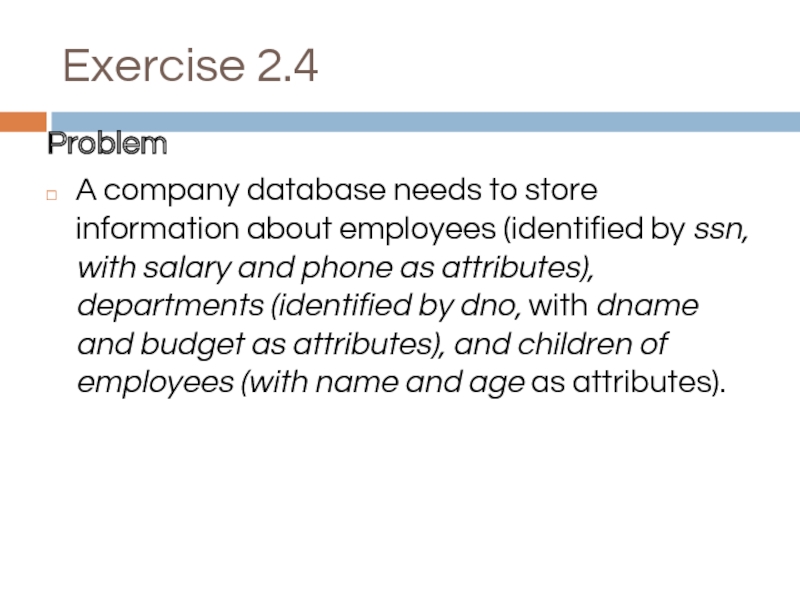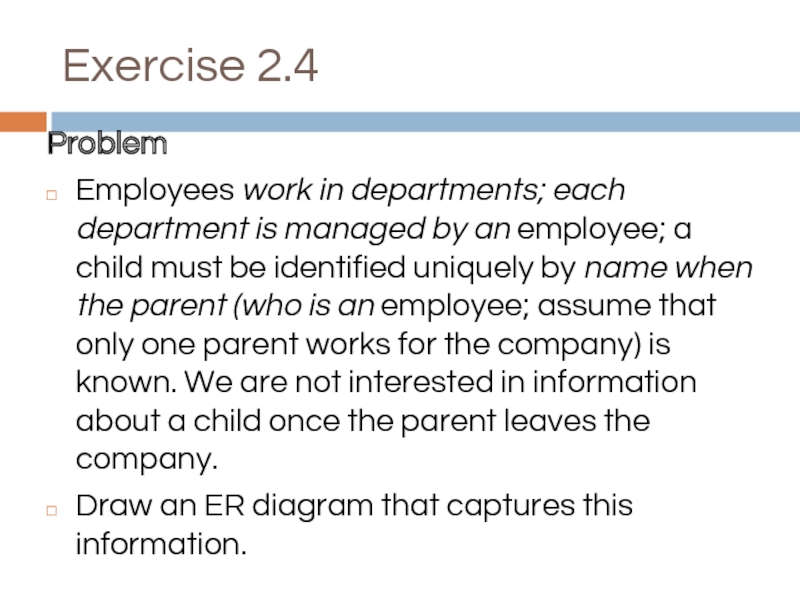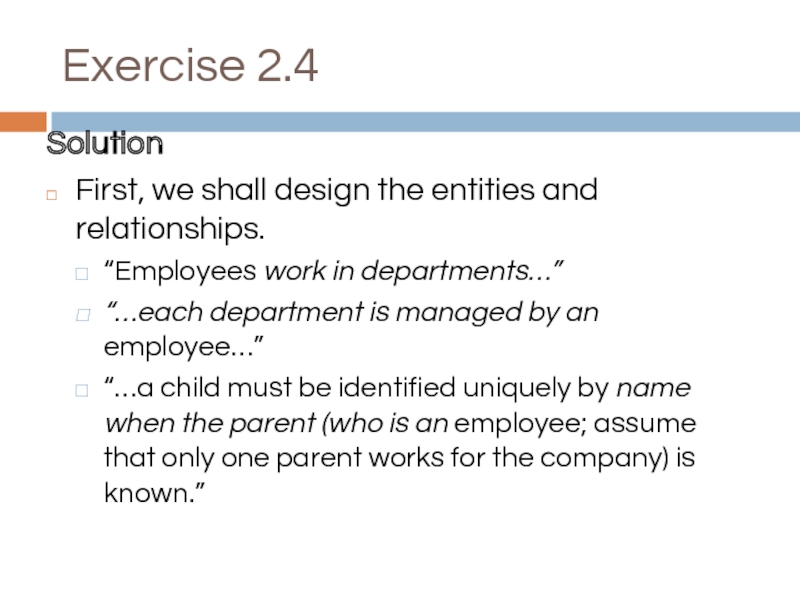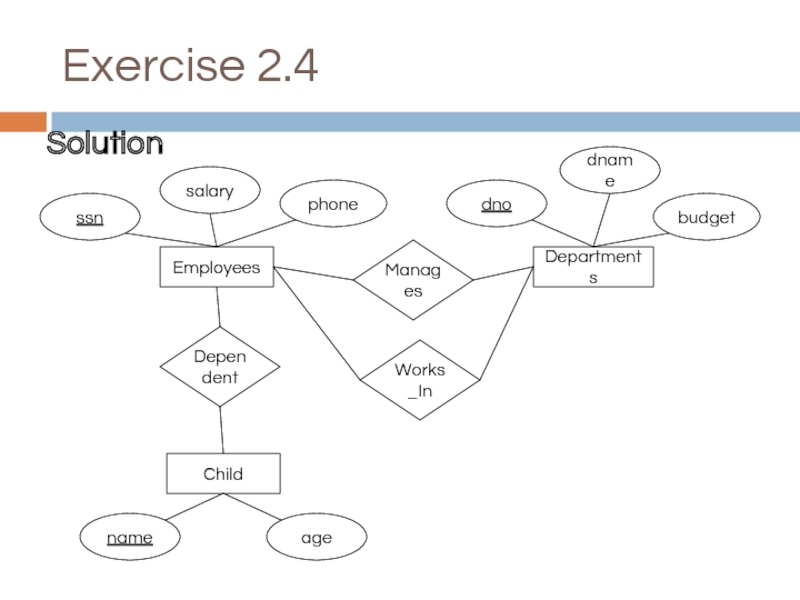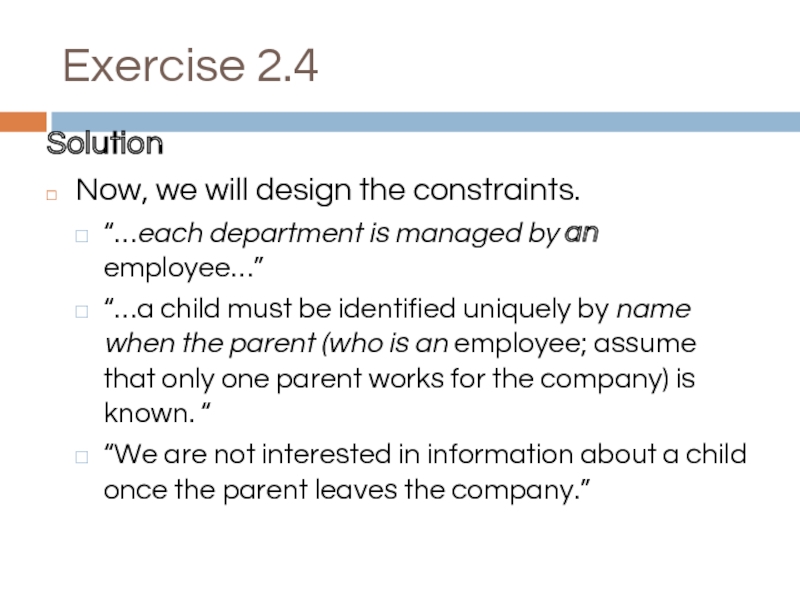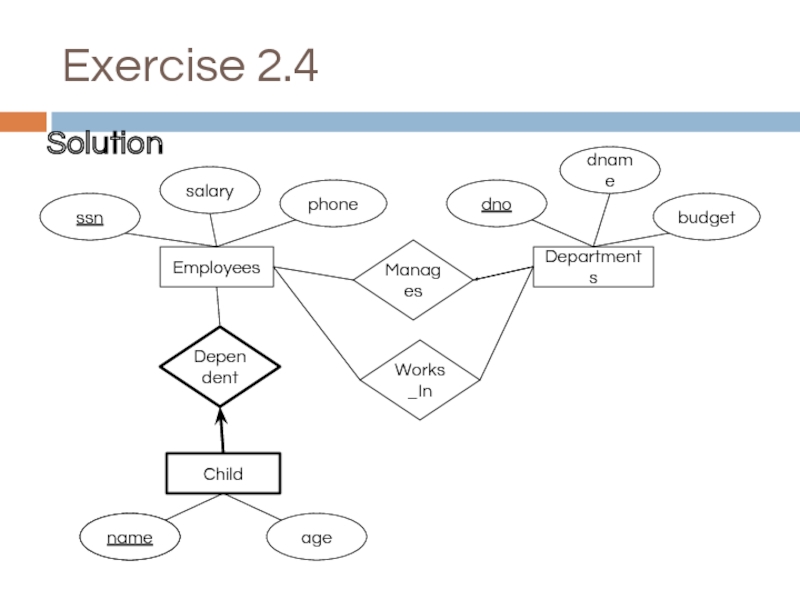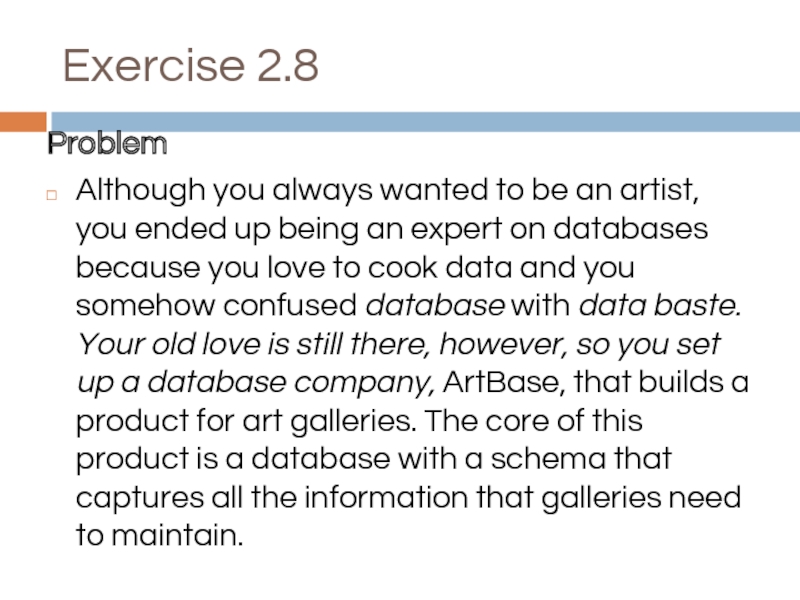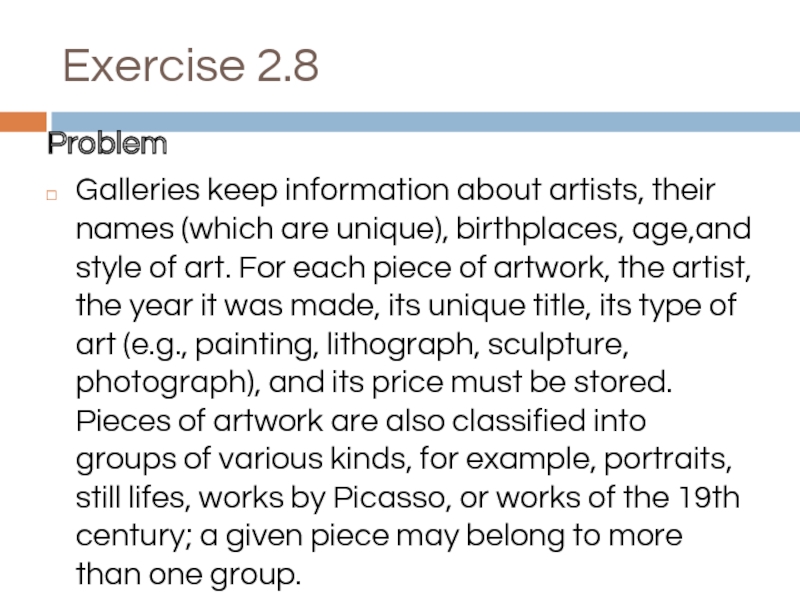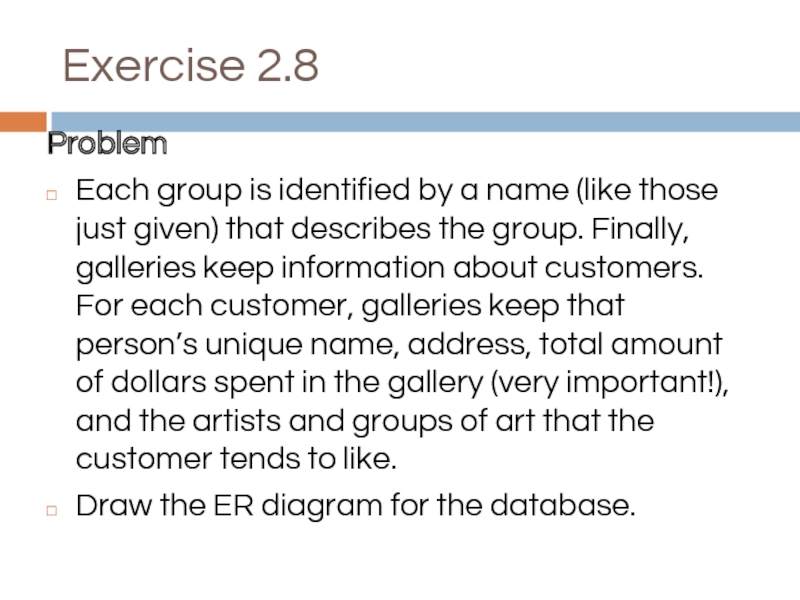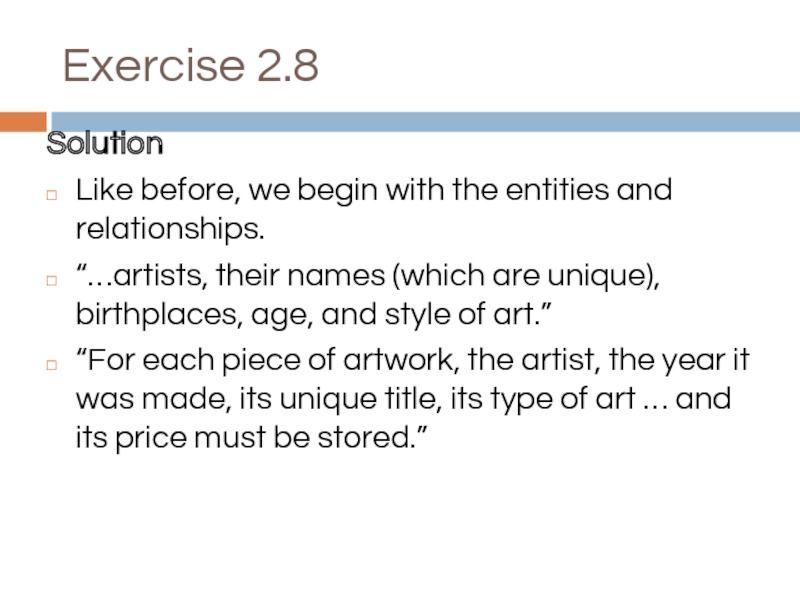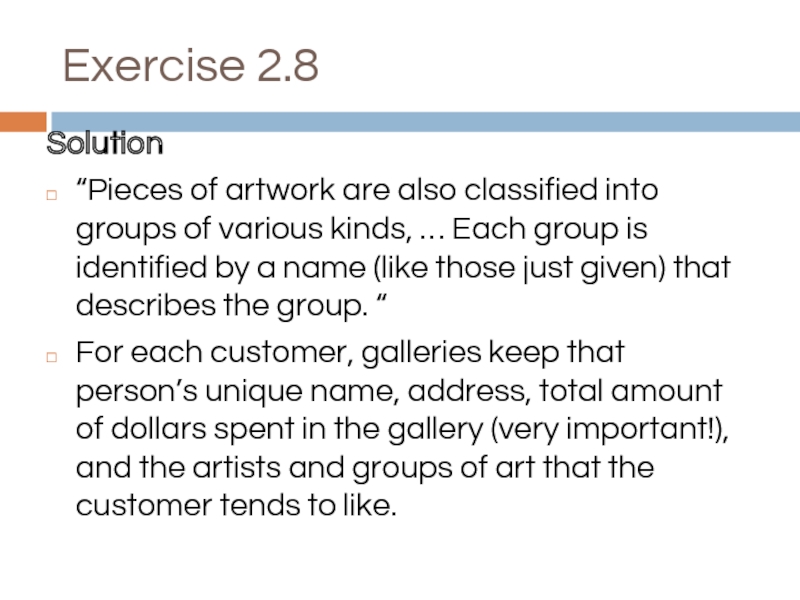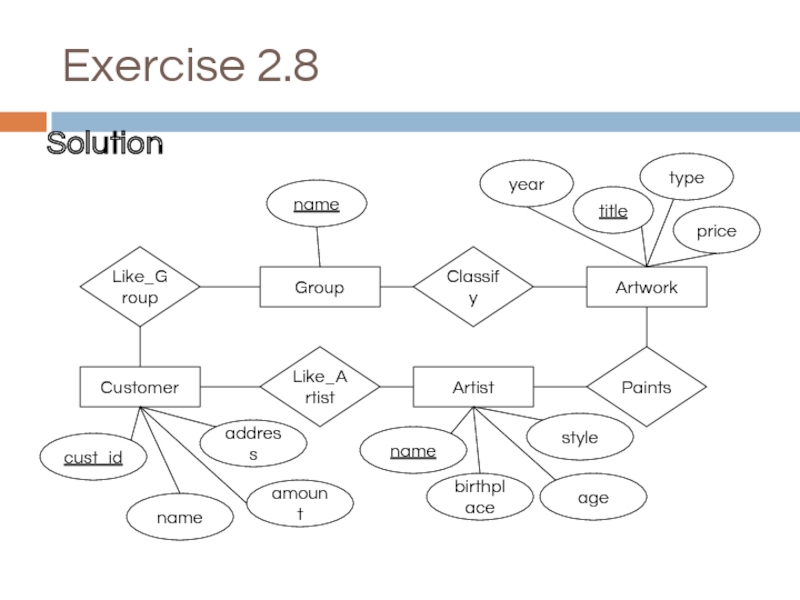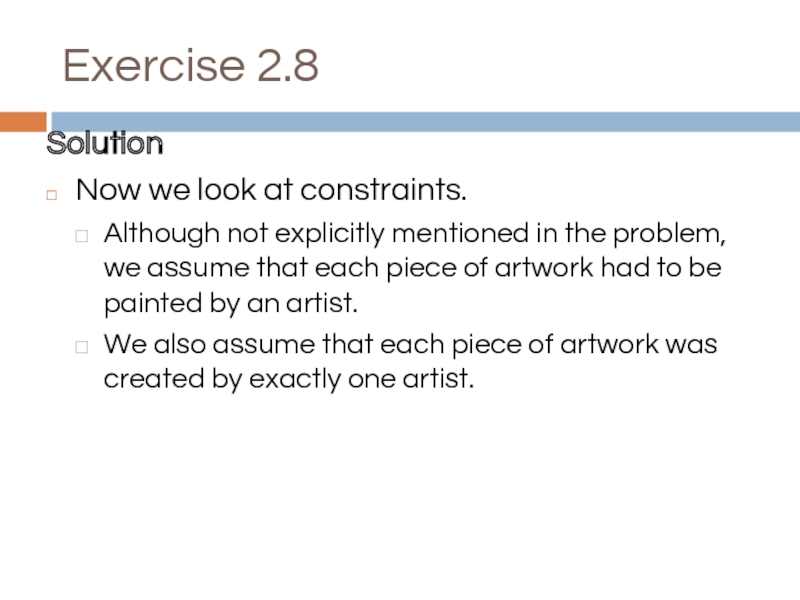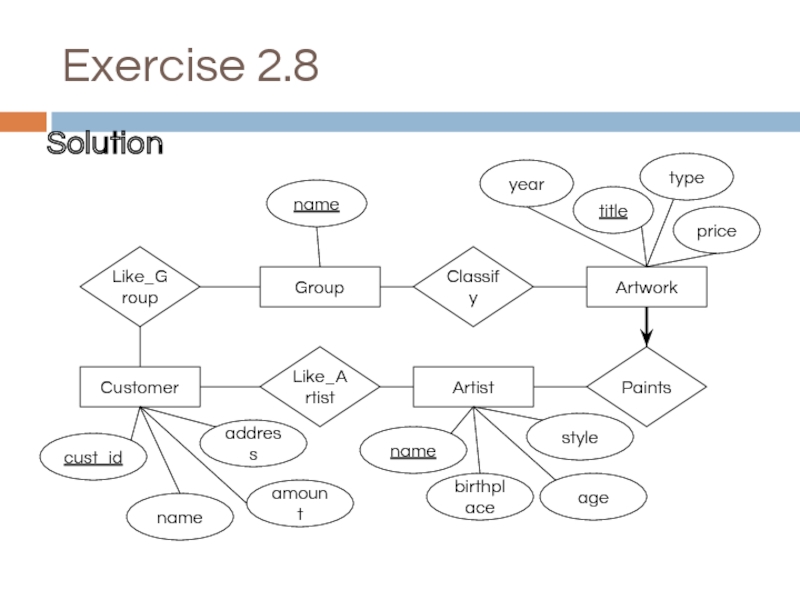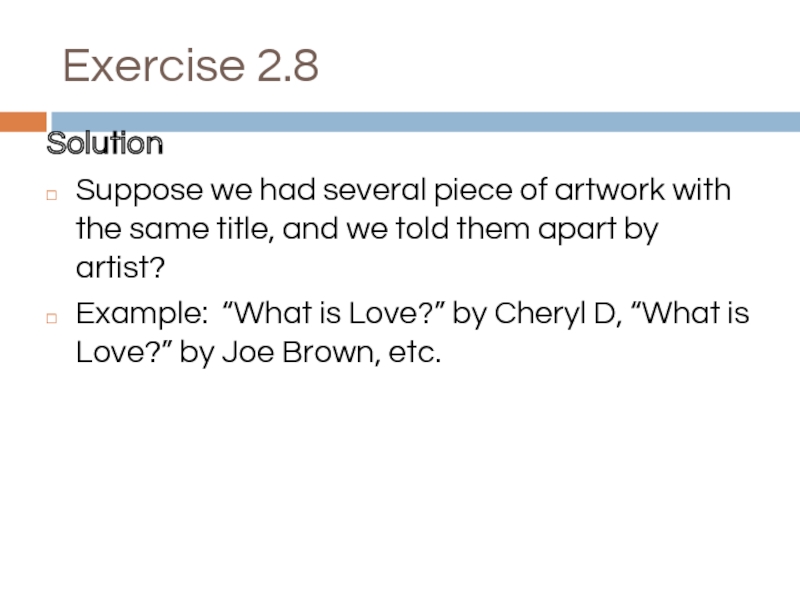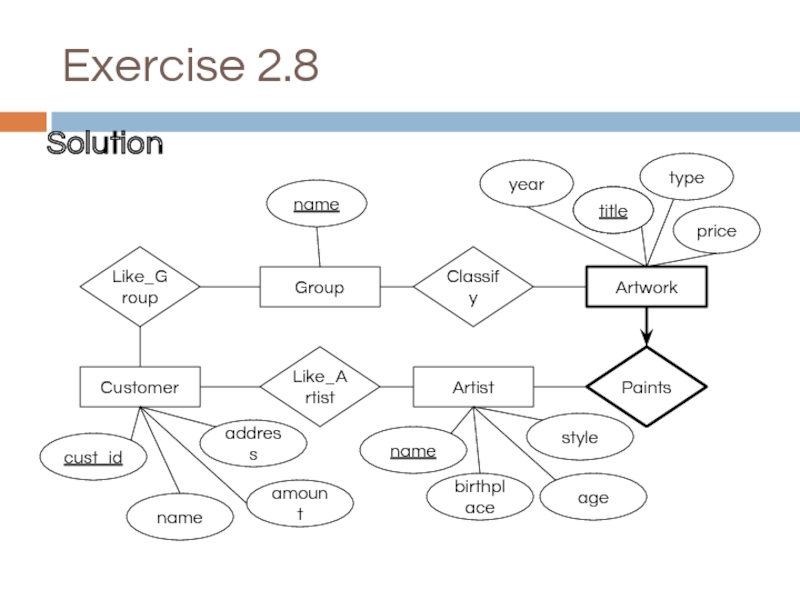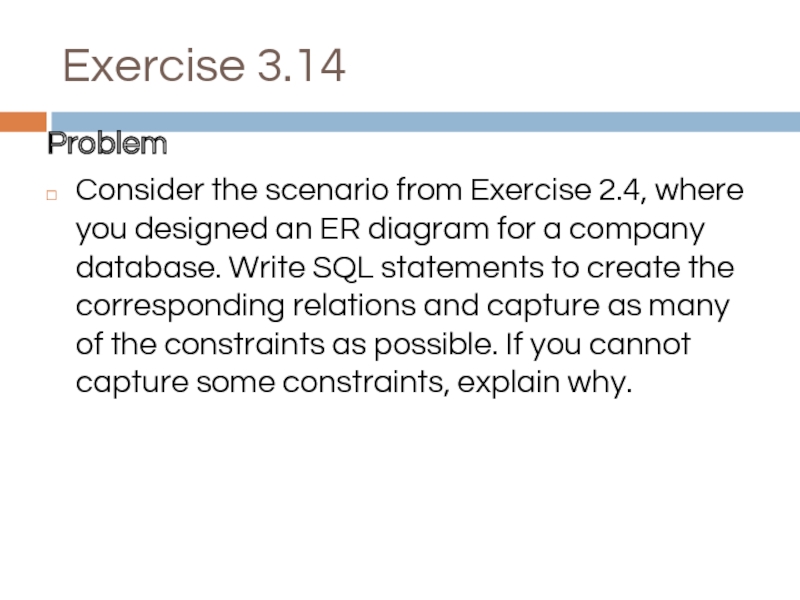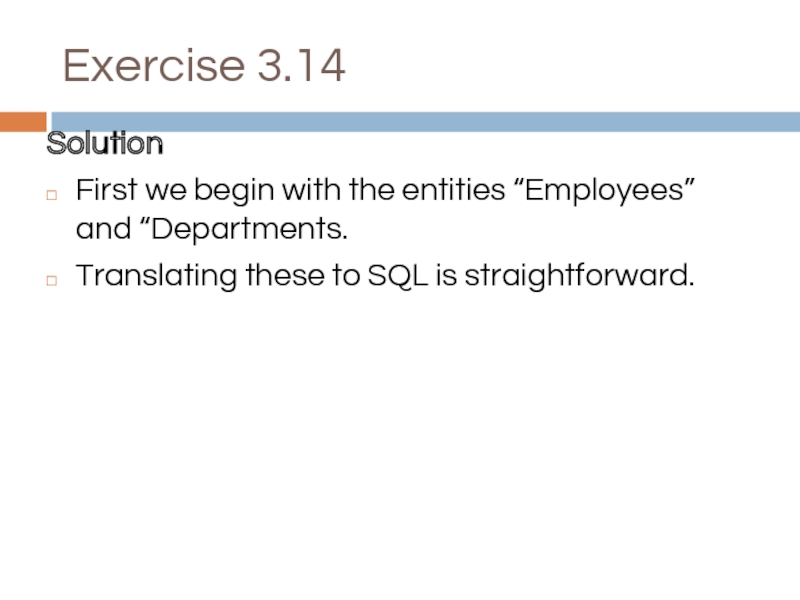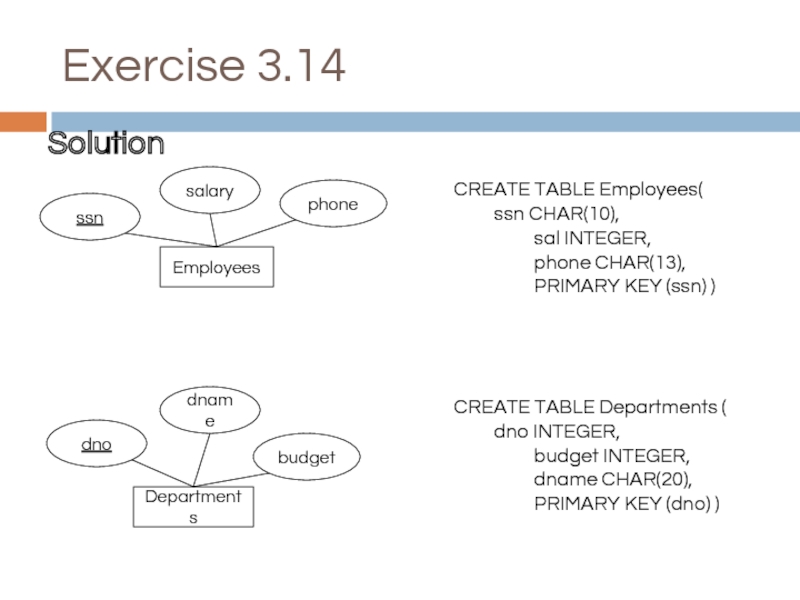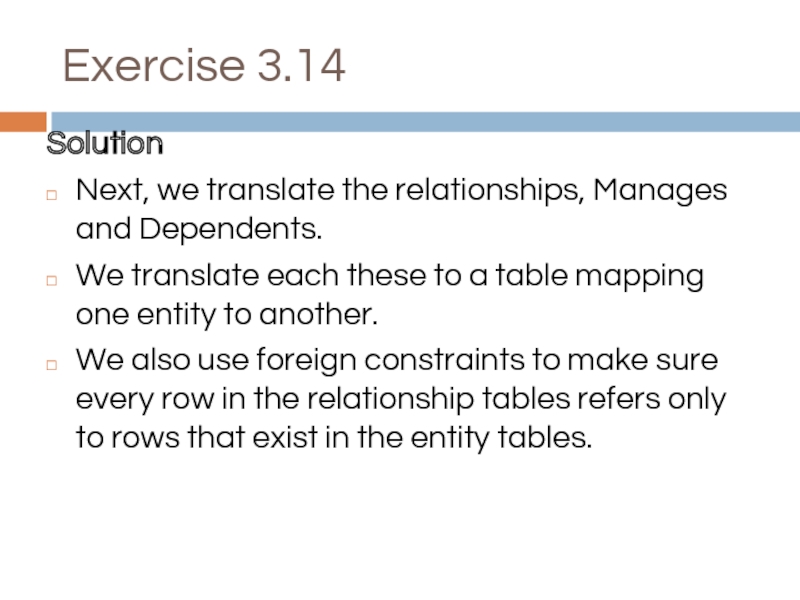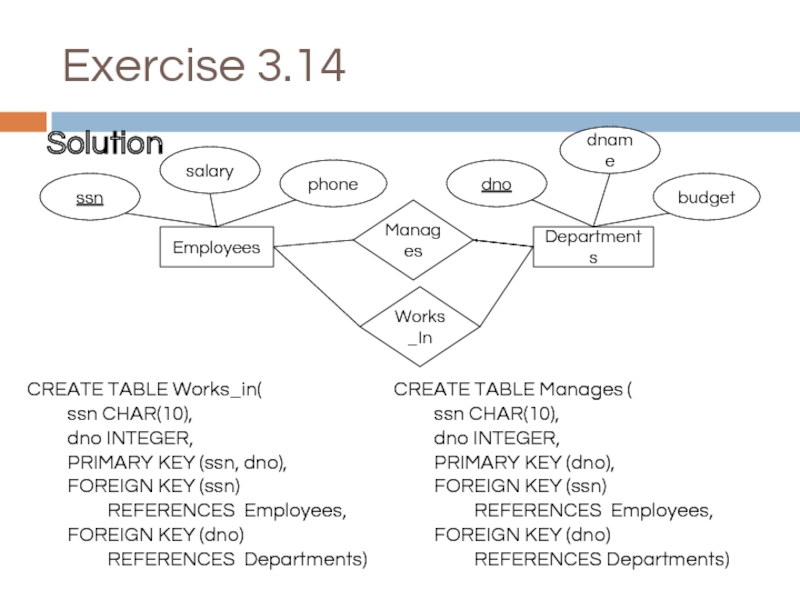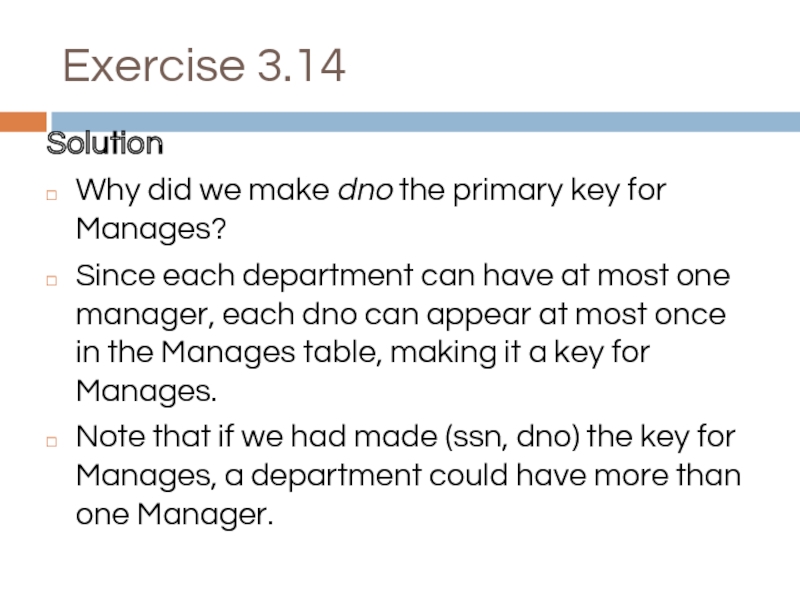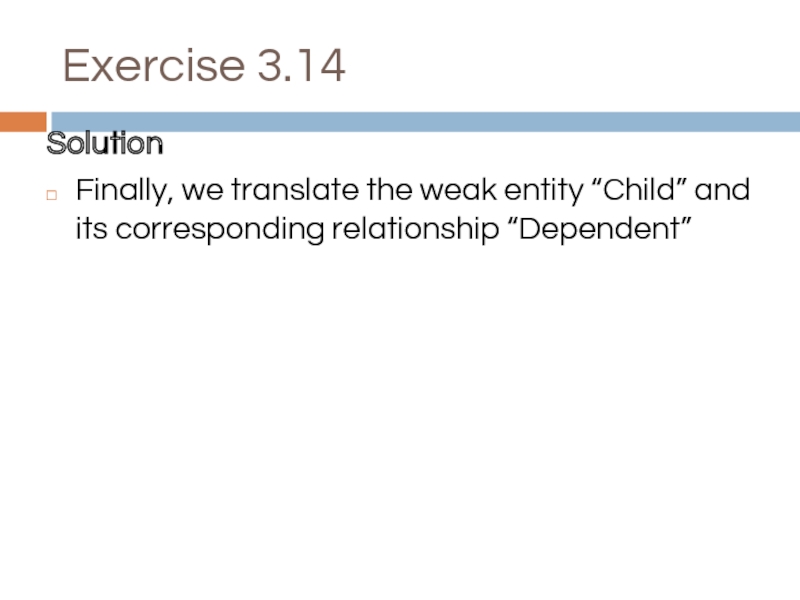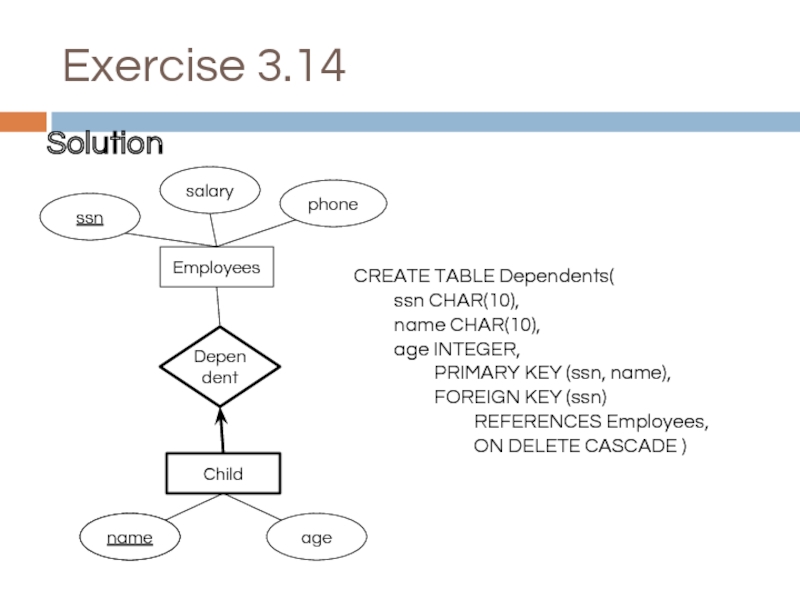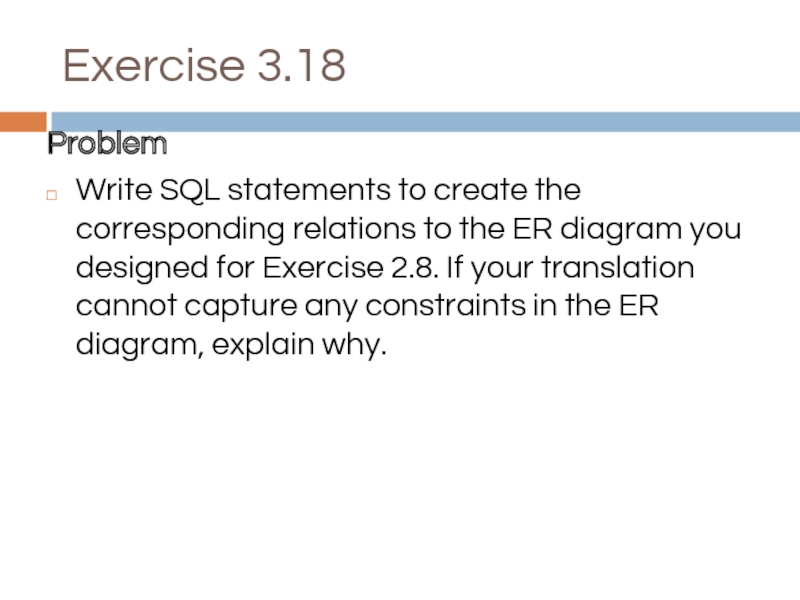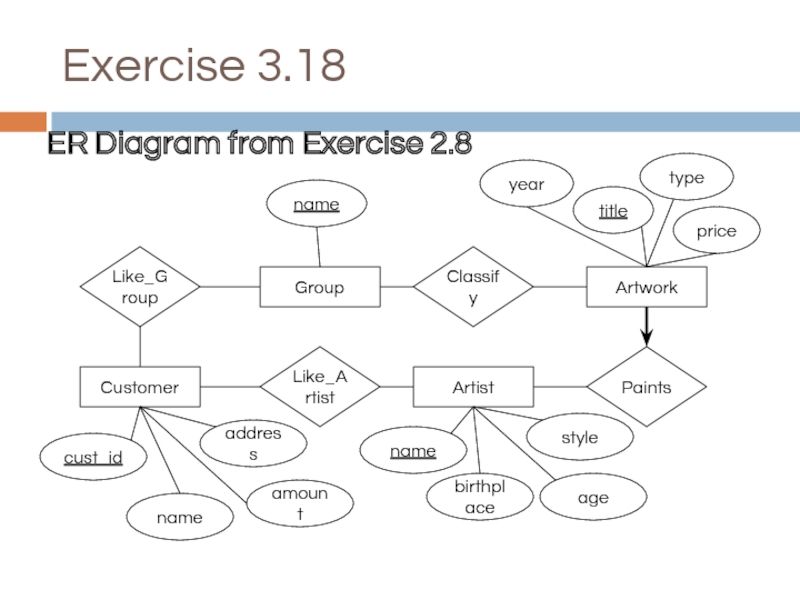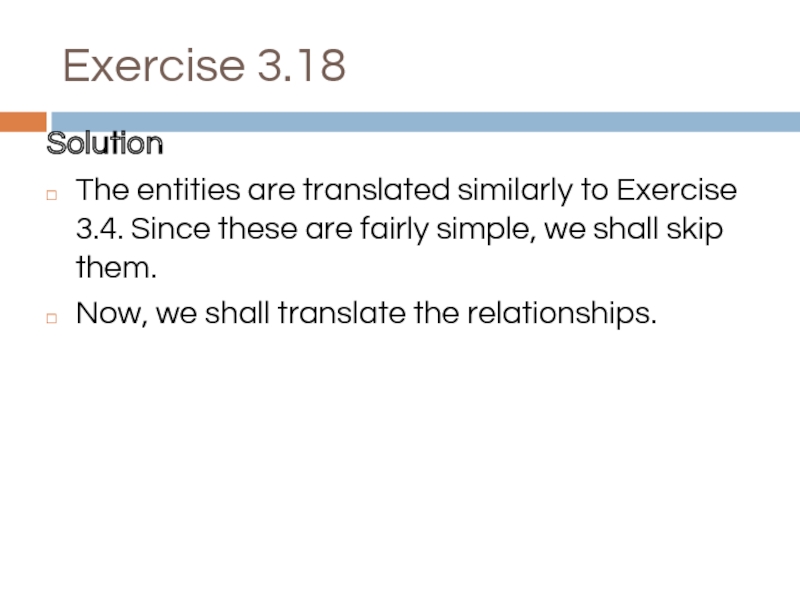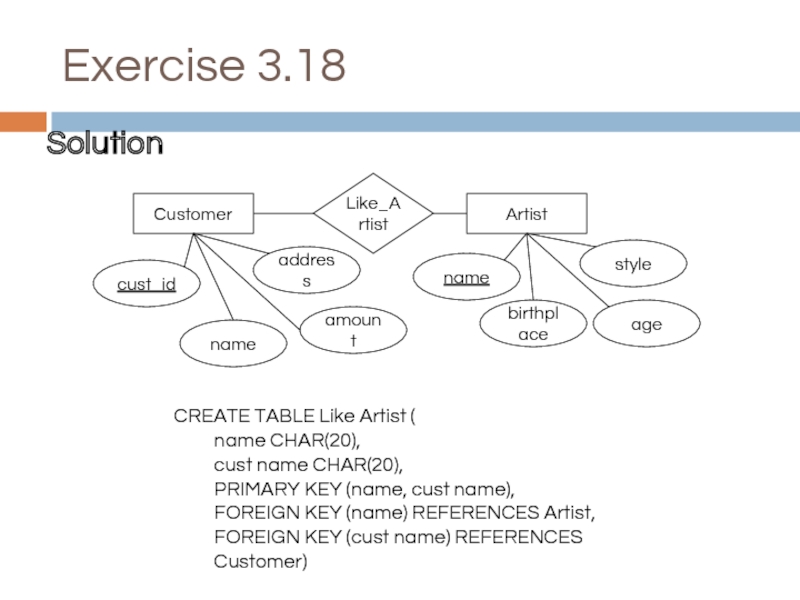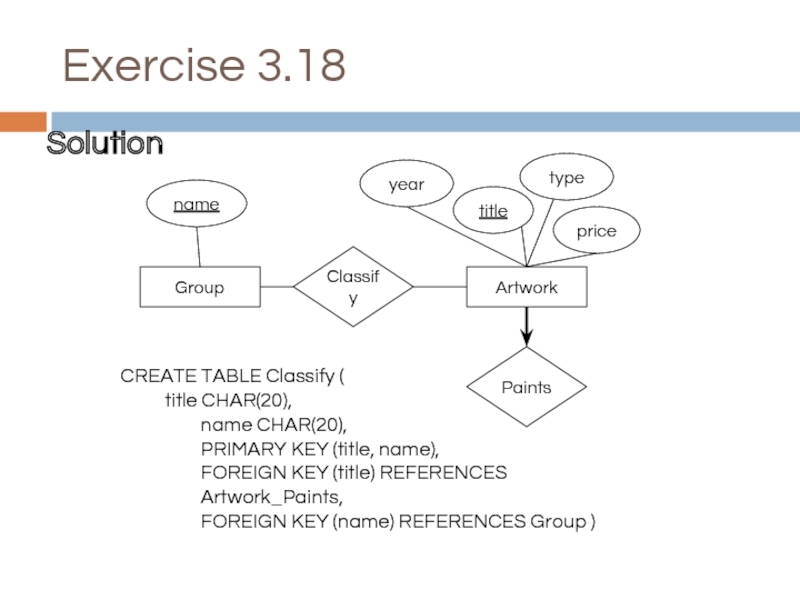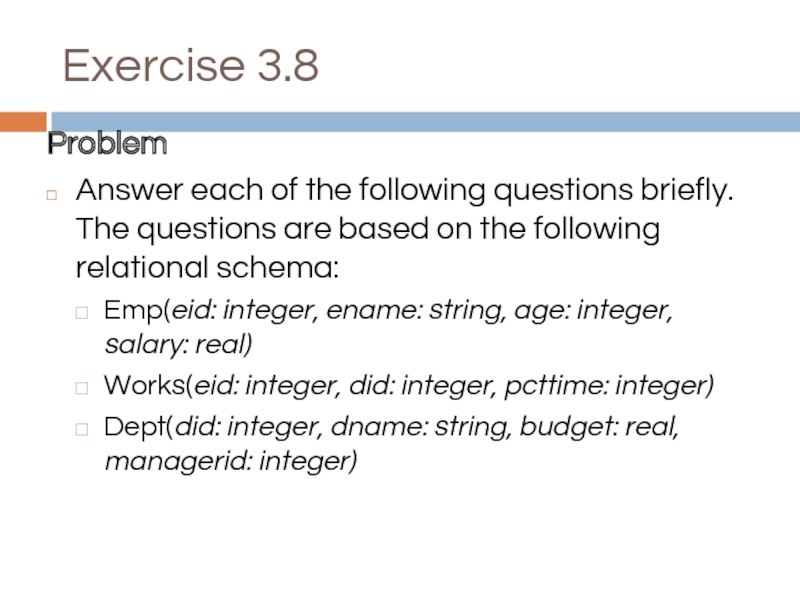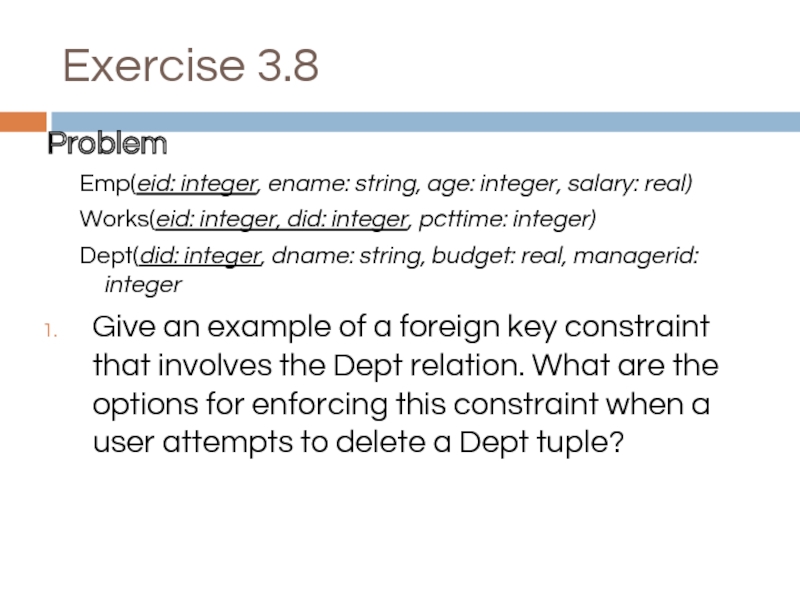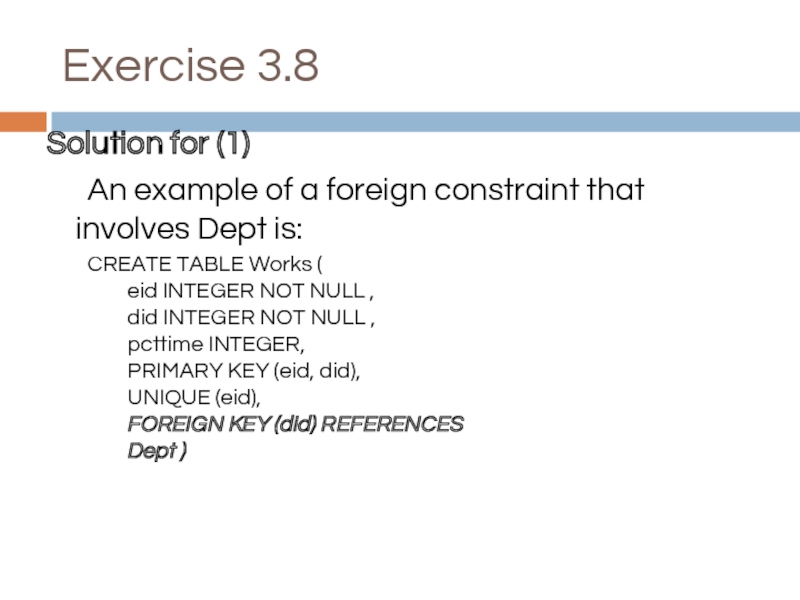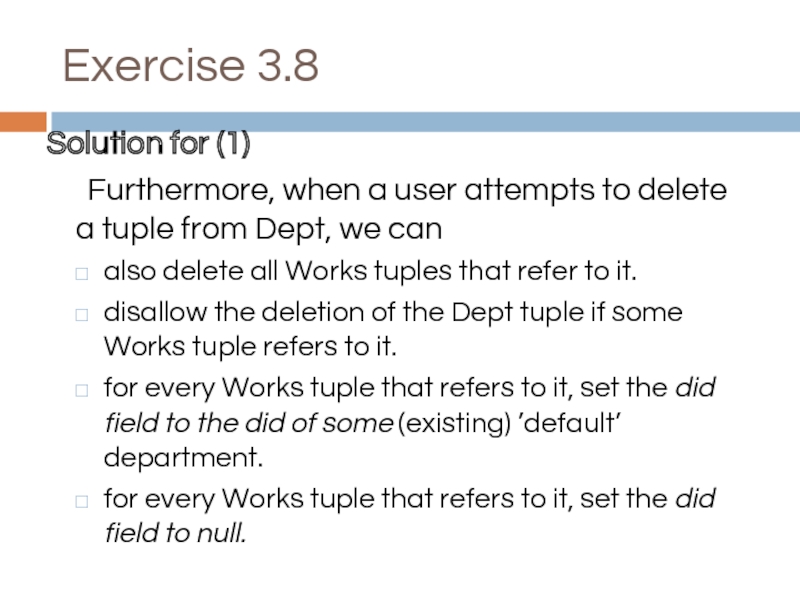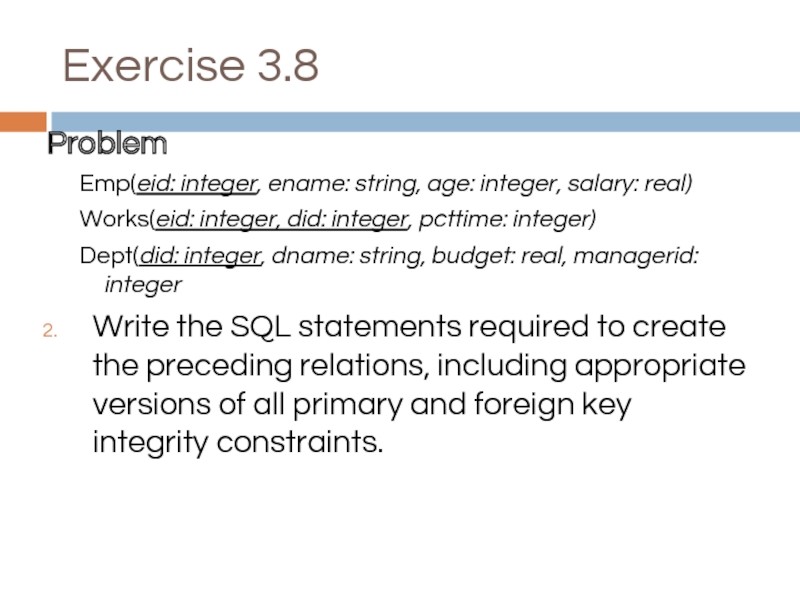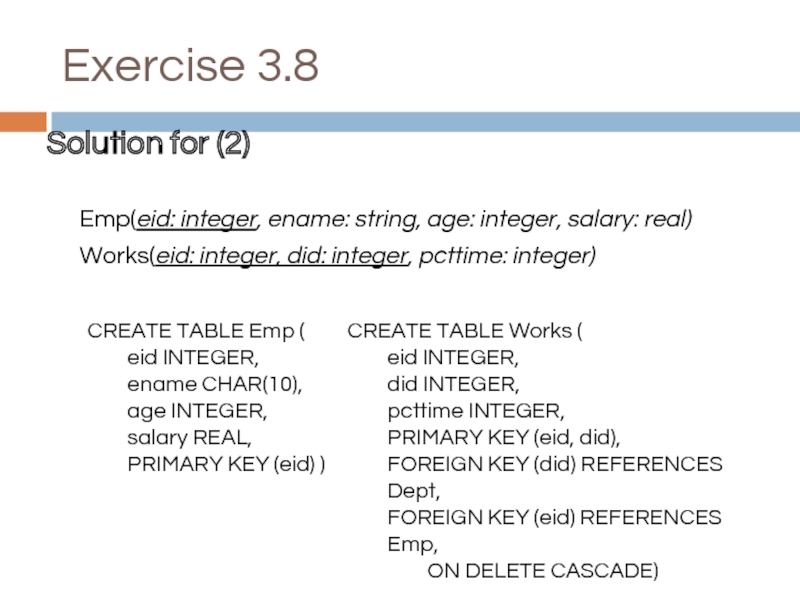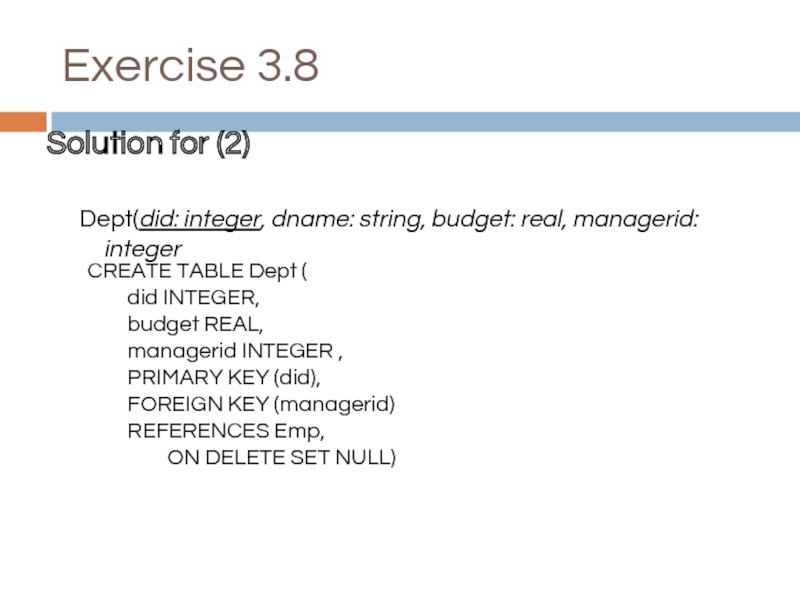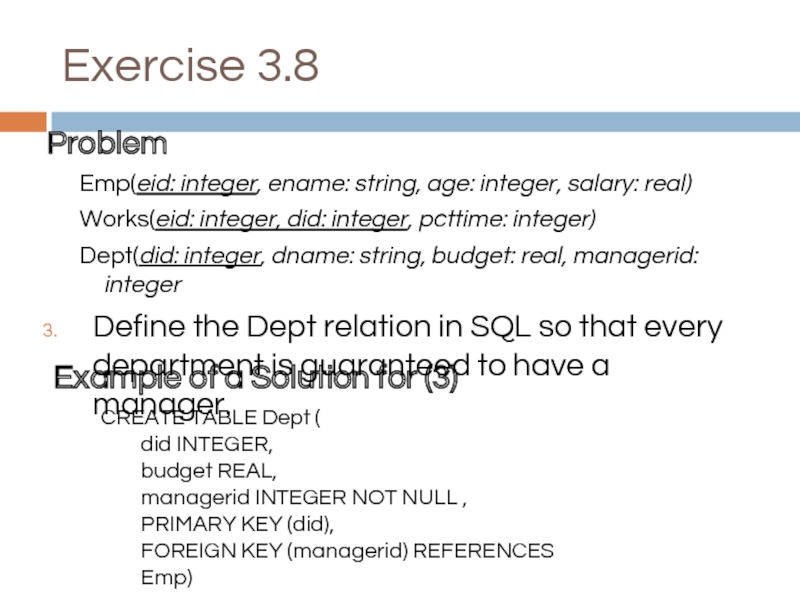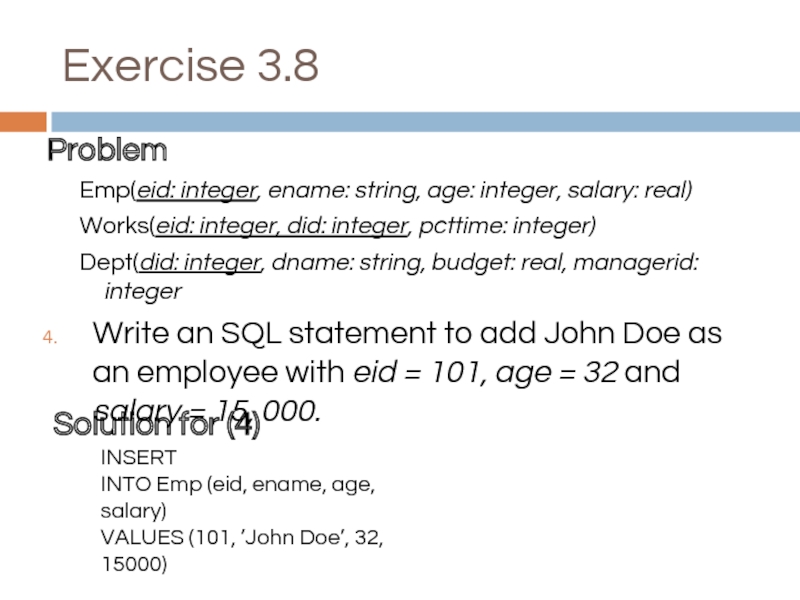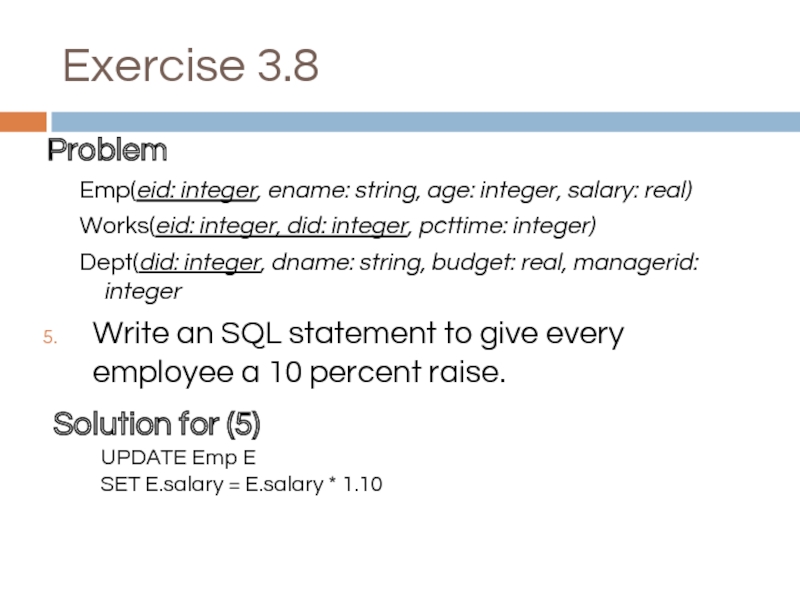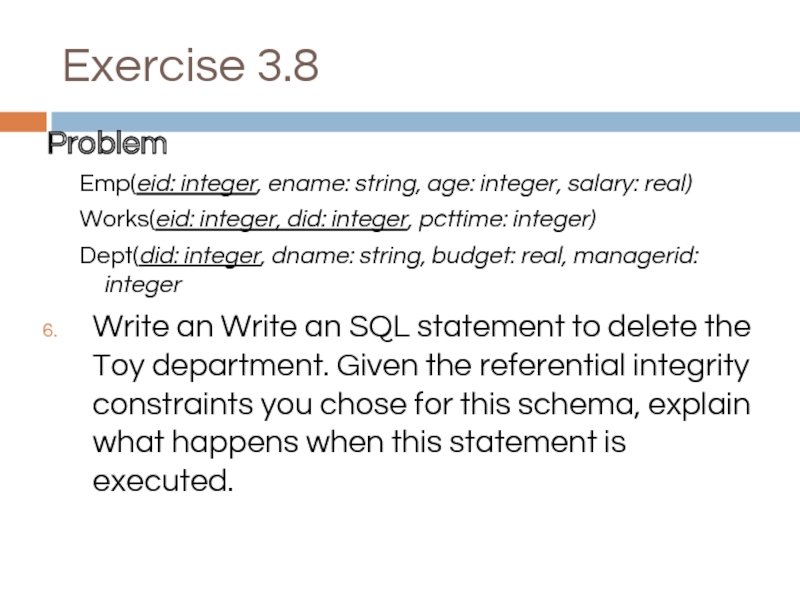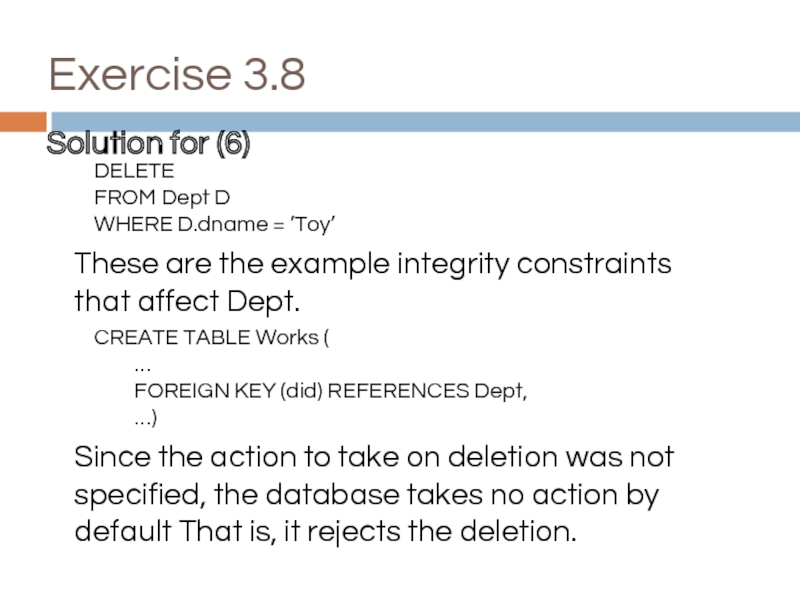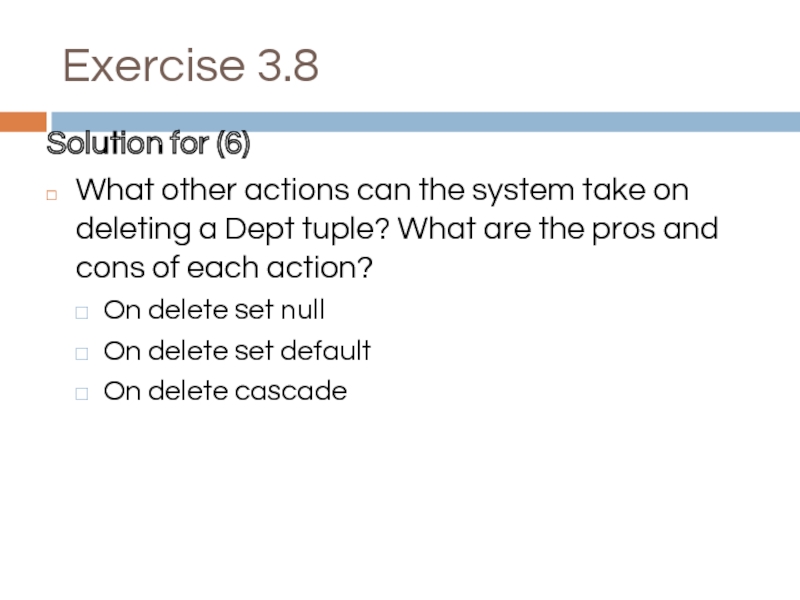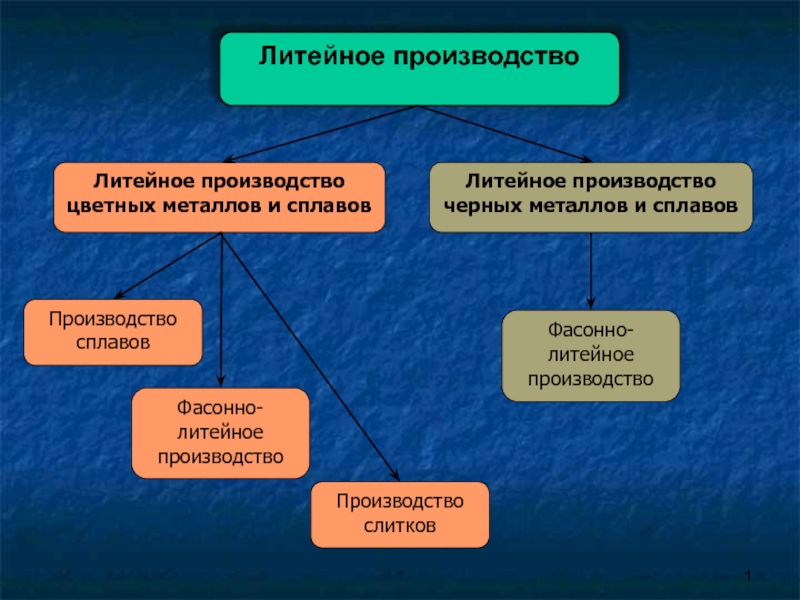- Главная
- Разное
- Дизайн
- Бизнес и предпринимательство
- Аналитика
- Образование
- Развлечения
- Красота и здоровье
- Финансы
- Государство
- Путешествия
- Спорт
- Недвижимость
- Армия
- Графика
- Культурология
- Еда и кулинария
- Лингвистика
- Английский язык
- Астрономия
- Алгебра
- Биология
- География
- Детские презентации
- Информатика
- История
- Литература
- Маркетинг
- Математика
- Медицина
- Менеджмент
- Музыка
- МХК
- Немецкий язык
- ОБЖ
- Обществознание
- Окружающий мир
- Педагогика
- Русский язык
- Технология
- Физика
- Философия
- Химия
- Шаблоны, картинки для презентаций
- Экология
- Экономика
- Юриспруденция
Practice exercises. Database design. Relational model. (Chapter 2, 3) презентация
Содержание
- 1. Practice exercises. Database design. Relational model. (Chapter 2, 3)
- 2. Exercise 2.4 Problem A company database needs
- 3. Exercise 2.4 Problem Employees work in departments;
- 4. Exercise 2.4 Solution First, we shall design
- 5. Exercise 2.4 Solution Departments Child Employees name
- 6. Exercise 2.4 Solution Now, we will design
- 7. Exercise 2.4 Solution Departments Child Employees name
- 8. Exercise 2.8 Problem Although you always wanted
- 9. Exercise 2.8 Problem Galleries keep information about
- 10. Exercise 2.8 Problem Each group is identified
- 11. Exercise 2.8 Solution Like before, we begin
- 12. Exercise 2.8 Solution “Pieces of artwork are
- 13. Exercise 2.8 Solution Artwork Group Customer Artist
- 14. Exercise 2.8 Solution Now we look at
- 15. Exercise 2.8 Solution Artwork Group Customer Artist
- 16. Exercise 2.8 Solution Suppose we had several
- 17. Exercise 2.8 Solution Artwork Group Customer Artist
- 18. Exercise 3.14 Problem Consider the scenario from
- 19. Exercise 3.14 ER Diagram from Exercise 2.4
- 20. Exercise 3.14 Solution First we begin with
- 21. Exercise 3.14 Solution Departments Employees phone ssn
- 22. Exercise 3.14 Solution Next, we translate the
- 23. Exercise 3.14 Solution Departments Employees phone ssn
- 24. Exercise 3.14 Solution Why did we make
- 25. Exercise 3.14 Solution Finally, we translate the
- 26. Exercise 3.14 Solution Child Employees name age
- 27. Exercise 3.18 Problem Write SQL statements to
- 28. Exercise 3.18 ER Diagram from Exercise 2.8
- 29. Exercise 3.18 Solution The entities are translated
- 30. Exercise 3.18 Solution Group Customer Like_Group name
- 31. Exercise 3.18 Solution Customer Artist Like_Artist birthplace
- 32. Exercise 3.18 Solution Artwork Artist Paints title
- 33. Exercise 3.18 Solution Artwork Group Classify
- 34. Exercise 3.8 Problem Answer each of the
- 35. Exercise 3.8 Problem Emp(eid: integer, ename: string,
- 36. Exercise 3.8 Solution for (1) An example
- 37. Exercise 3.8 Solution for (1) Furthermore, when
- 38. Exercise 3.8 Problem Emp(eid: integer, ename: string,
- 39. Exercise 3.8 Solution for (2) Emp(eid:
- 40. Exercise 3.8 Solution for (2) Dept(did:
- 41. Exercise 3.8 Problem Emp(eid: integer, ename: string,
- 42. Exercise 3.8 Problem Emp(eid: integer, ename: string,
- 43. Exercise 3.8 Problem Emp(eid: integer, ename: string,
- 44. Exercise 3.8 Problem Emp(eid: integer, ename: string,
- 45. Exercise 3.8 Solution for (6) DELETE FROM
- 46. Exercise 3.8 Solution for (6) What other
- 47. This is the end of the lecture! I hope you enjoyed it.
Слайд 1COP-5725
PRACTICE EXERCISES
Chapter 2: Database Design
Chapter 3: Relational Model
M. Amanda Crick
Слайд 2Exercise 2.4
Problem
A company database needs to store information about employees (identified
Слайд 3Exercise 2.4
Problem
Employees work in departments; each department is managed by an
Draw an ER diagram that captures this information.
Слайд 4Exercise 2.4
Solution
First, we shall design the entities and relationships.
“Employees work in
“…each department is managed by an employee…”
“…a child must be identified uniquely by name when the parent (who is an employee; assume that only one parent works for the company) is known.”
Слайд 5Exercise 2.4
Solution
Departments
Child
Employees
name
age
phone
ssn
salary
Dependent
budget
dno
dname
Manages
Works_In
Слайд 6Exercise 2.4
Solution
Now, we will design the constraints.
“…each department is managed by
“…a child must be identified uniquely by name when the parent (who is an employee; assume that only one parent works for the company) is known. “
“We are not interested in information about a child once the parent leaves the company.”
Слайд 7Exercise 2.4
Solution
Departments
Child
Employees
name
age
phone
ssn
salary
Dependent
budget
dno
dname
Manages
Works_In
Child
Dependent
name
Слайд 8Exercise 2.8
Problem
Although you always wanted to be an artist, you ended
Слайд 9Exercise 2.8
Problem
Galleries keep information about artists, their names (which are unique),
Слайд 10Exercise 2.8
Problem
Each group is identified by a name (like those just
Draw the ER diagram for the database.
Слайд 11Exercise 2.8
Solution
Like before, we begin with the entities and relationships.
“…artists, their
“For each piece of artwork, the artist, the year it was made, its unique title, its type of art … and its price must be stored.”
Слайд 12Exercise 2.8
Solution
“Pieces of artwork are also classified into groups of various
For each customer, galleries keep that person’s unique name, address, total amount of dollars spent in the gallery (very important!), and the artists and groups of art that the customer tends to like.
Слайд 13Exercise 2.8
Solution
Artwork
Group
Customer
Artist
Like_Group
Classify
Paints
Like_Artist
name
title
type
price
year
birthplace
style
age
name
name
address
amount
cust_id
Слайд 14Exercise 2.8
Solution
Now we look at constraints.
Although not explicitly mentioned in
We also assume that each piece of artwork was created by exactly one artist.
Слайд 15Exercise 2.8
Solution
Artwork
Group
Customer
Artist
Like_Group
Classify
Paints
Like_Artist
name
title
type
price
year
birthplace
style
age
name
name
address
amount
cust_id
Слайд 16Exercise 2.8
Solution
Suppose we had several piece of artwork with the same
Example: “What is Love?” by Cheryl D, “What is Love?” by Joe Brown, etc.
Слайд 17Exercise 2.8
Solution
Artwork
Group
Customer
Artist
Like_Group
Classify
Paints
Like_Artist
name
title
type
price
year
birthplace
style
age
name
name
address
amount
cust_id
Artwork
Paints
title
Слайд 18Exercise 3.14
Problem
Consider the scenario from Exercise 2.4, where you designed an
Слайд 19Exercise 3.14
ER Diagram from Exercise 2.4
Departments
Child
Employees
name
age
phone
ssn
salary
Dependent
budget
dno
dname
Manages
Works_In
Child
Dependent
name
Слайд 20Exercise 3.14
Solution
First we begin with the entities “Employees” and “Departments.
Translating these
Слайд 21Exercise 3.14
Solution
Departments
Employees
phone
ssn
salary
budget
dno
dname
CREATE TABLE Employees(
ssn CHAR(10),
sal INTEGER,
phone CHAR(13),
PRIMARY KEY (ssn) )
CREATE TABLE
dno INTEGER,
budget INTEGER,
dname CHAR(20),
PRIMARY KEY (dno) )
Слайд 22Exercise 3.14
Solution
Next, we translate the relationships, Manages and Dependents.
We translate each
We also use foreign constraints to make sure every row in the relationship tables refers only to rows that exist in the entity tables.
Слайд 23Exercise 3.14
Solution
Departments
Employees
phone
ssn
salary
budget
dno
dname
Manages
Works_In
CREATE TABLE Works_in(
ssn CHAR(10),
dno INTEGER,
PRIMARY KEY (ssn, dno),
FOREIGN KEY (ssn)
REFERENCES
FOREIGN KEY (dno)
REFERENCES Departments)
CREATE TABLE Manages (
ssn CHAR(10),
dno INTEGER,
PRIMARY KEY (dno),
FOREIGN KEY (ssn)
REFERENCES Employees,
FOREIGN KEY (dno)
REFERENCES Departments)
Слайд 24Exercise 3.14
Solution
Why did we make dno the primary key for Manages?
Since
Note that if we had made (ssn, dno) the key for Manages, a department could have more than one Manager.
Слайд 25Exercise 3.14
Solution
Finally, we translate the weak entity “Child” and its corresponding
Слайд 26Exercise 3.14
Solution
Child
Employees
name
age
phone
ssn
salary
Dependent
Child
Dependent
name
CREATE TABLE Dependents(
ssn CHAR(10),
name CHAR(10),
age INTEGER,
PRIMARY KEY (ssn, name),
FOREIGN KEY
ON DELETE CASCADE )
Слайд 27Exercise 3.18
Problem
Write SQL statements to create the corresponding relations to the
Слайд 28Exercise 3.18
ER Diagram from Exercise 2.8
Artwork
Group
Customer
Artist
Like_Group
Classify
Paints
Like_Artist
name
title
type
price
year
birthplace
style
age
name
name
address
amount
cust_id
Слайд 29Exercise 3.18
Solution
The entities are translated similarly to Exercise 3.4. Since these
Now, we shall translate the relationships.
Слайд 30Exercise 3.18
Solution
Group
Customer
Like_Group
name
name
address
amount
cust_id
CREATE TABLE Like Group (
name CHAR(20),
cust name CHAR(20),
PRIMARY KEY (name,
FOREIGN KEY (name) REFERENCES Group,
FOREIGN KEY (cust name) REFERENCES Customer)
Слайд 31Exercise 3.18
Solution
Customer
Artist
Like_Artist
birthplace
style
age
name
name
address
amount
cust_id
CREATE TABLE Like Artist (
name CHAR(20),
cust name CHAR(20),
PRIMARY KEY (name,
FOREIGN KEY (name) REFERENCES Artist,
FOREIGN KEY (cust name) REFERENCES Customer)
Слайд 32Exercise 3.18
Solution
Artwork
Artist
Paints
title
type
price
year
birthplace
style
age
name
CREATE TABLE Artwork Paints(
title CHAR(20),
artist name CHAR(20),
type CHAR(20),
price INTEGER,
year INTEGER,
PRIMARY
FOREIGN KEY (artist name)
REFERENCES Artist)
Слайд 33Exercise 3.18
Solution
Artwork
Group
Classify
name
title
type
price
year
CREATE TABLE Classify (
title CHAR(20),
name CHAR(20),
PRIMARY KEY (title, name),
FOREIGN
FOREIGN KEY (name) REFERENCES Group )
Paints
Слайд 34Exercise 3.8
Problem
Answer each of the following questions briefly. The questions are
Emp(eid: integer, ename: string, age: integer, salary: real)
Works(eid: integer, did: integer, pcttime: integer)
Dept(did: integer, dname: string, budget: real, managerid: integer)
Слайд 35Exercise 3.8
Problem
Emp(eid: integer, ename: string, age: integer, salary: real)
Works(eid: integer, did:
Dept(did: integer, dname: string, budget: real, managerid: integer
Give an example of a foreign key constraint that involves the Dept relation. What are the options for enforcing this constraint when a user attempts to delete a Dept tuple?
Слайд 36Exercise 3.8
Solution for (1)
An example of a foreign constraint that involves
CREATE TABLE Works (
eid INTEGER NOT NULL ,
did INTEGER NOT NULL ,
pcttime INTEGER,
PRIMARY KEY (eid, did),
UNIQUE (eid),
FOREIGN KEY (did) REFERENCES Dept )
Слайд 37Exercise 3.8
Solution for (1)
Furthermore, when a user attempts to delete a
also delete all Works tuples that refer to it.
disallow the deletion of the Dept tuple if some Works tuple refers to it.
for every Works tuple that refers to it, set the did field to the did of some (existing) ’default’ department.
for every Works tuple that refers to it, set the did field to null.
Слайд 38Exercise 3.8
Problem
Emp(eid: integer, ename: string, age: integer, salary: real)
Works(eid: integer, did:
Dept(did: integer, dname: string, budget: real, managerid: integer
Write the SQL statements required to create the preceding relations, including appropriate versions of all primary and foreign key integrity constraints.
Слайд 39Exercise 3.8
Solution for (2)
Emp(eid: integer, ename: string, age: integer, salary: real)
Works(eid:
CREATE TABLE Emp (
eid INTEGER,
ename CHAR(10),
age INTEGER,
salary REAL,
PRIMARY KEY (eid) )
CREATE TABLE Works (
eid INTEGER,
did INTEGER,
pcttime INTEGER,
PRIMARY KEY (eid, did),
FOREIGN KEY (did) REFERENCES Dept,
FOREIGN KEY (eid) REFERENCES Emp,
ON DELETE CASCADE)
Слайд 40Exercise 3.8
Solution for (2)
Dept(did: integer, dname: string, budget: real, managerid: integer
CREATE
did INTEGER,
budget REAL,
managerid INTEGER ,
PRIMARY KEY (did),
FOREIGN KEY (managerid) REFERENCES Emp,
ON DELETE SET NULL)
Слайд 41Exercise 3.8
Problem
Emp(eid: integer, ename: string, age: integer, salary: real)
Works(eid: integer, did:
Dept(did: integer, dname: string, budget: real, managerid: integer
Define the Dept relation in SQL so that every department is guaranteed to have a manager.
CREATE TABLE Dept (
did INTEGER,
budget REAL,
managerid INTEGER NOT NULL ,
PRIMARY KEY (did),
FOREIGN KEY (managerid) REFERENCES Emp)
Example of a Solution for (3)
Слайд 42Exercise 3.8
Problem
Emp(eid: integer, ename: string, age: integer, salary: real)
Works(eid: integer, did:
Dept(did: integer, dname: string, budget: real, managerid: integer
Write an SQL statement to add John Doe as an employee with eid = 101, age = 32 and salary = 15, 000.
INSERT
INTO Emp (eid, ename, age, salary)
VALUES (101, ’John Doe’, 32, 15000)
Solution for (4)
Слайд 43Exercise 3.8
Problem
Emp(eid: integer, ename: string, age: integer, salary: real)
Works(eid: integer, did:
Dept(did: integer, dname: string, budget: real, managerid: integer
Write an SQL statement to give every employee a 10 percent raise.
UPDATE Emp E
SET E.salary = E.salary * 1.10
Solution for (5)
Слайд 44Exercise 3.8
Problem
Emp(eid: integer, ename: string, age: integer, salary: real)
Works(eid: integer, did:
Dept(did: integer, dname: string, budget: real, managerid: integer
Write an Write an SQL statement to delete the Toy department. Given the referential integrity constraints you chose for this schema, explain what happens when this statement is executed.
Слайд 45Exercise 3.8
Solution for (6)
DELETE
FROM Dept D
WHERE D.dname = ’Toy’
Since the action
CREATE TABLE Works (
…
FOREIGN KEY (did) REFERENCES Dept,
…)
These are the example integrity constraints that affect Dept.
Слайд 46Exercise 3.8
Solution for (6)
What other actions can the system take on
On delete set null
On delete set default
On delete cascade

